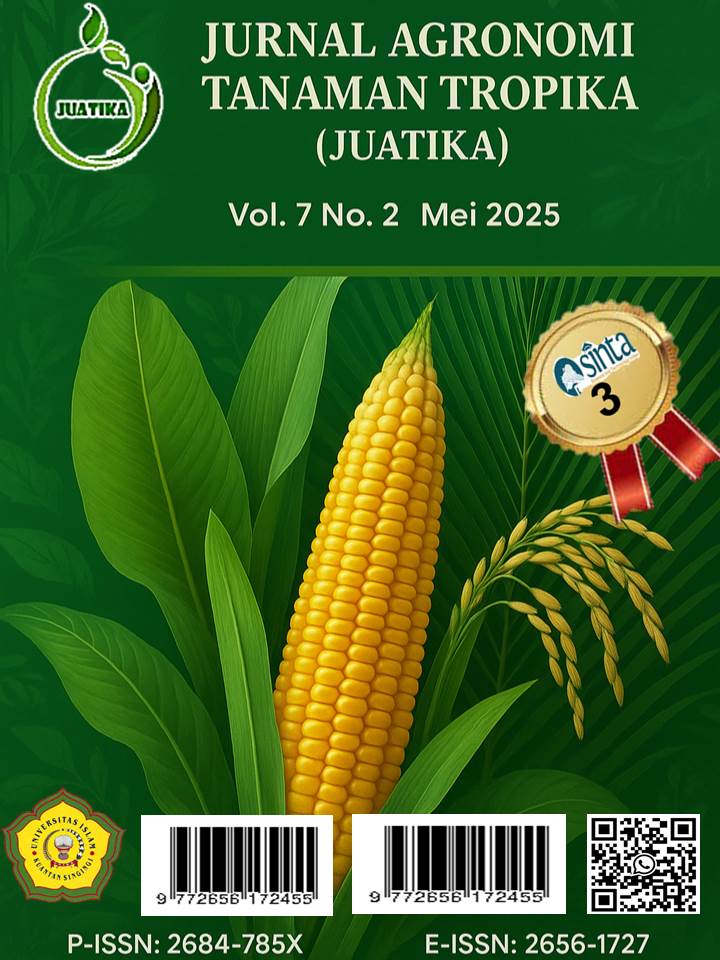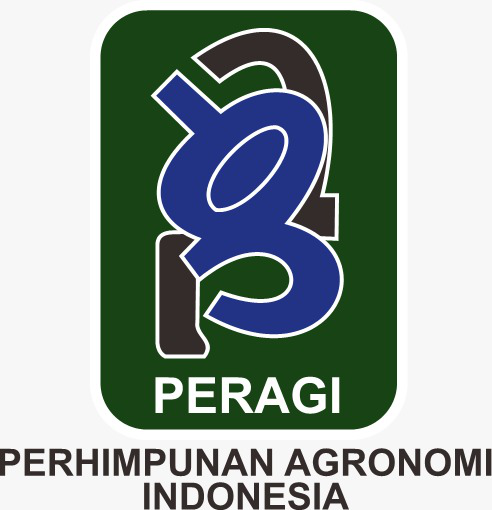Increasing the Growth and Production of Chili Plants (Capsicum annum var longum) by administering various Concentrations and Doses of JAKABA Biofertilizer
Abstract
Chile is a commodity characterized by volatile prices and is a significant contributor to inflation in the Indonesian economy. The agricultural sector faces several challenges, including technical cultivation issues, pest and disease infestations, and low productivity. An innovative fertilization approach utilizing Jakaba biofertilizer, derived from fermented organic matter rich in nutrients and microbes, was explored to address these challenges. This research aimed to evaluate the effectiveness of Jakaba in cultivating chili plants. This research used a factorial method with a completely randomized design (CRD). The first factor was the dosage of Jakaba fertilizer, which consisted of three levels: 100 ml, 200 ml, and 300 ml. The second factor was the fertilizer concentration, with 20 ml/L, 50 ml/L, 90 ml/L, and 140 ml/L. The results indicated that the application of Jakaba biofertilizer, in terms of both concentration and dosage, had a similar effect on all growth parameters of chili plants. The microbiological analysis involved isolating microbes from the biological fertilizer yielded 10 microbial isolates, comprising 4 fungal isolates and 6 bacterial isolates. The study revealed a carbon-to-nitrogen (C/N) ratio 6.598, indicating that the fertilizer had undergone decomposition and contained low nutrient content. Nutrient analysis showed an organic carbon content of 0.239%, total nitrogen of 0.0365%, a C/N ratio of 6.598, a P2O5 value of 0.02125%, and a total potassium (K) value of 0.0205%.
Downloads
References
Ananto, & Alatas, A. (2022). Application of vegetable and fruit waste liquid organic fertilizer (POC) as nutrition for red chili pepper plant growth (Capsicum annuum L.). JUATIKA Jurnal Agronomi Tanaman Tropika, 4(1), 216–221.
Farhanah, A., Hamzah, F., Kaharuddin, Atika, & Pari, R. F. (2024). Produksi tanaman selada merah secara vertikultur dengan pemberian POC Jakaba. Jurnal Agrisistem, 20(1), 1–8.
Nazari, A. P. D., Susylowati, & Putri, S. E. (2023). Pertumbuhan dan hasil tanaman terung ungu (Solanum melongena L.) dengan pemberian pupuk organik cair kulit pisang. Jurnal Agroekoteknologi Tropika Lembab, 5(2), 92–99.
Ammurabi, S. D., Anas, I., & Nugroho, B. (2020). Substitusi sebagian pupuk kimia dengan pupuk organik hayati pada jagung (Zea mays): Partly substitution of chemical fertilizer with bio-organic fertilizer on maize (Zea mays). Jurnal Ilmu Tanah dan Lingkungan, 22(1), 10–15. https://doi.org/10.29244/jitl.22.1.10-15
Ibnusina, F., Km, J. R. N., Pati, T., & Barat, S. (2024). Efek pemberian Jakaba terhadap pertumbuhan dan produksi tanaman sawi hijau (Brassica juncea L.) pada tanah organosol. Jurnal Agrikultura, 35(2), 250–258.
Norliyani, A., Santi, M., Huda, J., & Mahdiannoor, M. (2023). Budidaya cabai merah menggunakan JAKABA di lahan podsolik: Red chilli cultivation using JAKABA in podzolic land. Daun: Jurnal Ilmiah Pertanian dan Kehutanan, 10(1), 125–142. https://doi.org/10.33084/daun.v10i1.4395
Patti, P. S., Kaya, E., & Silahooy, C. (2013). Analisis status nitrogen tanah dalam kaitannya dengan serapan N oleh tanaman padi sawah di Desa Waimital, Kecamatan Kairatu, Kabupaten Seram Bagian Barat. Jurnal Agrologia, 2(1).
Pratiwi, H., Darmawati, A., & Budiyanto, S. (2021). Pengaruh konsentrasi dan frekuensi pemberian POC limbah tahu terhadap pertumbuhan dan produksi cabai merah (Capsicum annuum L.). Jurnal Buana Sains, 21(1), 87–98.
Rahmawati, Y., Akbar, Y., Sabri, Y., & Desriana. (2023). Optimalisasi pemberian beberapa konsentrasi pupuk organik cair (POC) Jakaba terhadap pertumbuhan bibit kelapa sawit (Elaeis guineensis Jacq.). Menara Ilmu, 17(1), 80–88.
Ralahalu, M. A., Hehanussa, M. L., & Oszaer, L. L. (2013). Respons tanaman cabai besar (Capsicum annuum) terhadap pemberian pupuk organik hormon tanaman unggul. Agrologia, 2(2), 144–150.
Rahmah, A., Izzati, M., Parman, S., & Biologi, J. (2014). Pengaruh pupuk organik cair berbahan dasar limbah sawi putih (Brassica chinensis L.) terhadap pertumbuhan tanaman jagung manis (Zea mays L. var. saccharata). Buletin Anatomi dan Fisiologi, 22(1), 65–71.
Sarah, Rahmatan, H., & Supriatno. (2016). Pengaruh pemberian berbagai konsentrasi urin kambing yang difermentasi terhadap pertumbuhan vegetatif lada (Piper nigrum L.). Jurnal Ilmiah Mahasiswa Pendidikan Biologi, 7(2), 107–115.
Sartini. (2021). Mengenal pupuk nitrogen dan fungsinya bagi tanaman. https://balittra.litbang.pertanian.go.id. Diakses pada 25 September 2022.
Setiyadi, Y. (2020). Pengertian pH tanah dan pengaruhnya terhadap pertumbuhan tanaman. https://ensiklo.com. Diakses pada 27 September 2022.
Siregar, R. S., Septyani, I. A. P., Adam, D. H., & Triyanto, Y. (2024). Increasing red chili plants (Capsicum annuum L.) growth rate by administering photosynthetic bacteria (PSB) fertilizer and NPK fertilizer. JUATIKA Jurnal Agronomi Tanaman Tropika, 6(2), 538–546.
Sutanto, R. (2002). Penerapan pertanian organik: Permasyarakatan dan pengembangannya. Kanisius.
Wulandari, N. K. R., Madrini, I. A. G. B., & Wijaya, I. M. A. S. (2020). Efek penambahan limbah makanan terhadap C/N ratio pada pengomposan limbah kertas. Biosistem dan Teknik Pertanian, 8(1), 103–112.
Zahra Alhafiza, N., Syah, R. F., & Kristalisasi, E. N. (2025). Isolation and potential test of phosphate-solubilizing bacteria in the rhizosphere of mangrove plants (Rhizophora mucronata Poir) as isolates for biofertilizer. JUATIKA Jurnal Agronomi Tanaman Tropika, 7(1). https://doi.org/10.36378/juatika.v7i1.3865
Zulhadyanto, R. (2020). Keracunan besi (Fe) pada tanaman padi sawah bukaan baru dan cara pencegahannya. https://dppp.bangkaselatankab.go.id
Copyright (c) 2025 Ryan Firman Syah, Hangger Gahara Mawandha, Helmi Afroda, Wilen Yonglie

This work is licensed under a Creative Commons Attribution 4.0 International License.
Authors who publish with Jurnal Agronomi Tanaman Tropika (JUATIKA) agree to the following terms:
Authors retain copyright and grant the Jurnal Agronomi Tanaman Tropika (JUATIKA) right of first publication with the work simultaneously licensed under a Creative Commons Attribution License (CC BY 4.0) that allows others to share (copy and redistribute the material in any medium or format) and adapt (remix, transform, and build upon the material for any purpose, even commercially) with an acknowledgment of the work's authorship and initial publication in Jurnal Agronomi Tanaman Tropika (JUATIKA).
Authors are able to enter into separate, additional contractual arrangements for the non-exclusive distribution of the journal's published version of the work (e.g., post it to an institutional repository or publish it in a book), with an acknowledgment of its initial publication in Jurnal Agronomi Tanaman Tropika (JUATIKA). Authors are permitted and encouraged to post their work online (e.g., in institutional repositories or on their website) prior to and during the submission process, as it can lead to productive exchanges, as well as earlier and greater citation of published work.







 More Information
More Information



